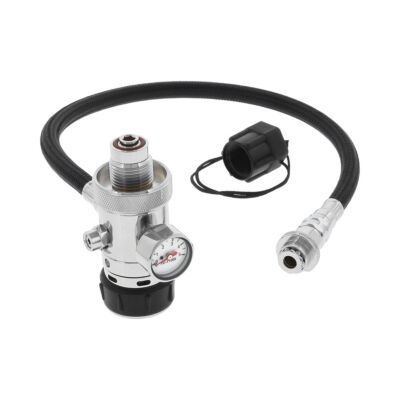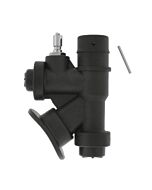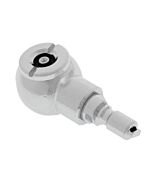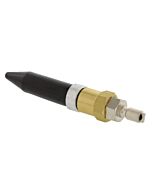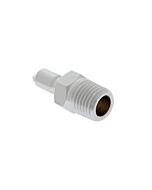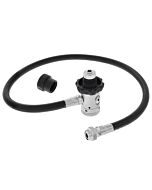DGX Custom - EZ-ON Regulator Kit
- Complete regulator system for power inflation or compressed air tools
- Low profile balanced piston DIN first stage with an IP of 120 psi
- Choose the hose length for your specific needs
- Three LP 3/8-inch ports - one HP 7/16-inch port
- Includes mini-SPG and quick disconnect adapter
DGX Custom - EZ-ON Regulator Kit
The system consists of a low profile balanced piston DIN 1st stage - the DGX Gears FIRST regulator plus a flex hose in your choice of length along with an EZ-ON quick disconnect adapter that accepts the standard drysuit or BC inflator QD post, an over pressure relief valve (OPV) and a mini-SPG in your choice of PSI or BAR. Also included is a DIN cap to protect the fitting when not in use.
Nitrox Ready and suitable for use with air or argon, the DGX Inflation Regulator has balanced piston first stage with an intermediate pressure of 120 psi and includes an over pressurization relief valve. This balanced piston first stage provides unusually good performance for such inexpensive system; suitable for inflation applications to { 330 fsw | 100 msw}. Also popular for use with SCUBA cylinders to supply booster drive gas. Measuring {4.0 in x 1.5 in | 10.2 cm x 3.8 cm}, the regulator offers three standard size low pressure 3/8-inch ports (one is used by the OPV), one standard size high pressure 7/16-inch port (used by the mini-SPG), and comes standard with a 200-BAR DIN connector.
For applications with a yoke style SCUBA tank valve you may also wish to add a DIN-to-Yoke spin on adapter.
To assemble:
- Connect regulator first stage to the outlet of the gas supply cylinder
- Connect hose to a device with a BC QD post and manually operated valve
- Open the supply cylinder valve using the cylinder valve handwheel
- Operate the device as needed using the manually operated valve of the device or supply cylinder
To disassemble
- Close the cylinder valve using the cylinder valve handwheel
- Bleed line pressure using the manually operated valve of the device
- Disconnect hose from the BC QD post of the device
- Disconnect regulator first stage from the outlet of the gas supply cylinder
To bleed line pressure, do NOT use the OPV, unscrew the Schrader valve in the hose, or disassemble the first stage regulator. In an circumstance where the line has been inadvertently pressurized and a device with a manually operated valve and BC QD post is not conveniently available, then very slowly unscrew a port plug from the first stage body. Note this will likely cause the port plug O-ring to be dislodged and probably damaged, necessitating replacement. You might wish to keep an QD post Air Nozzle handy as an alternative.
FYI, the Milton Industries M-style (aka Industrial Interchange Type 'D') quick connect coupling is widely used with compressed air driven industrial tools and is not compatible with the standard BC QD used in SCUBA inflation applications.
| Brand | DGX |
|---|---|
| SKU | PK-545001 |
| Weight | 2.000000 |
Customer Reviews
 WARNING
WARNING
There is NO universal standard that defines the precise shape and exact dimensions of the compressed gas quick-connect coupling systems used on BCD and drysuit inflators. The different low-flow posts are in theory compatible with the same Schrader valve female coupler, thus you will often see inflator hoses with the same BC QD coupler marketed for use with both BCD and drysuit inflation valves. However, in our experience the hoses with couplers designed for one style of post are less likely to be entirely compatible with another style post. We have also encountered occasional incompatibilities in the fittings even within the same style, especially when there are many years difference in age between the female coupling and the male post.
These circumstances can cause compatibility issues with the connection: the fittings will not connect at all; the fittings will not securely connect and can self-disconnect without any overt user action; the fittings will securely connect but gas will not flow; the fittings will connect but can exhibit leaks. Whenever using 3rd party connectors you should always be careful to validate compatibility of the connectors.
When using any quick connect / quick disconnect fitting system, best practice is to fully retract the locking collar, push the female fitting completely on the post, while holding the fitting down on the post release the locking collar, visually ensure the collar is fully locked, then pull back on the hose to ensure the fitting is solidly locked on the post.
YOU MAY ALSO BE INTERESTED IN THE FOLLOWING PRODUCT(S)
Choosing the Best Inflation Hose Length
For BC power inflator hoses with the ordinary quick-disconnect Schrader fitting, the most common length seen on the 'jacket' style BC is {26 in | 66 cm} or {28 in | 71 cm} because the large-diameter corrugated hose length is relatively long and most sport first stage regulators are 'fixed' port orientations which can result in less than optimal hose routing. Our observation of divers in the water is these one-length-fits-all hoses are often too long, causing the hose to 'bow' out and the inflator assembly to lay at an inconvenient or improper location with the resulting increase in drag. Using a shorter BC hose is particularly beneficial if the diver has added a powered alert whistle inline with the BC power-inflator.
For divers using back inflation, the typical length seen on the 'wing' style BC is {22 in | 56 cm} because the large-diameter corrugated hose is usually a little shorter on wings. This length generally works well on singles where the regulator first stage has swivel ports and on doubles where the hose will coming off the 5th port of the divers right post regulator. Some cave divers prefer a short corrugated hose where the inflator rests at their shoulder rather than their chest, and the BC power-inflator hose is typically {18 in | 46 cm} long. We don't have a recommendation for sidemount divers as the lengths are very sensitive to the configuration, but the {15 in | 38 cm} length is popular and we even see some sidemount rigs using {9 in | 23 cm} hoses, although with short hoses A-framing can be an issue.
BC integrated backup second stages are a special case and require a hi-flow quick coupling. You can not use a standard BC inflator QD hose Schrader fitting to supply a BC integrated alternate air source, as the device would not receive enough gas due to the flow restriction of a standard Schrader fitting. To replace the hose for one of these devices, you will need to use a {26 in | 66 cm} LP regulator hose plus a BC Integrated 2nd Stage Adapter.
Most drysuit inflation systems use the same fitting as found on BCs, but need a longer length. For drysuit divers, where the hose routes under their arm to a chest mounted power-inflator, the typical length is {30 in | 76 cm} or sometimes {36 in | 91 cm} depending on the locations of the power-inflator relative to the first stage supply. We've also seen some drysuit inflation systems which relied upon a special flow-restrictor orifice in the first stage fitting of the hose rather than in the inflator valve itself and while the drysuit inflator hose appears to be the same as an ordinary BC inflator hose, it is not the same. You should consult the manual that came with your drysuit to be certain your drysuit inflator valve can use a standard BC inflator hose.
Finally, we sometimes hear from someone seeking a BC hose for the backup power-inflator of their redundant bladder wing. There is controversy regarding the use of dual bladder wings, and we won't join the debate here. However, rapidly diagnosing a dribbling or runaway power-inflator plus other issues introduced by an additional BC inflation hose, leads some experienced divers who choose to dive with redundant bladder wings to avoid connecting the backup power-inflator. Instead the backup BC is only inflated orally in an emergency.
